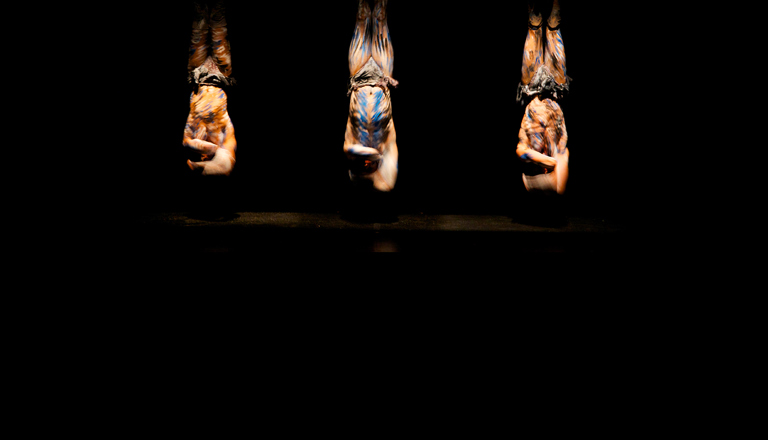Mutton Bird (2008)
After Viewing
Pose questions that remind them of their experience.
- How many dancers are on the stage at the beginning of the dance?
- What position are they in?
- Are they male or female?
- What are they wearing?
- What is on their skin and hair?
- Do any of the dancers leave the stage? When?
- One of the dancers is holding something. What is that?
- From which body part/s are they hanging?
Identify some of the main ideas and select and clarify information from the student’s responses.
- Which dancer do you think has a different role in the dance to the others?
- How can you tell he is different?
- Why do you think the three dancers are hanging upside down?
- There is a stick-like prop above the dancers. What could this represent?
The dance Mutton Bird represents a life source of food for the traditional people.
- Why might the choreographer have chosen to represent the mutton birds in this way?
- Why is the harvesting of these birds important to Tasmanian Aboriginal people?
Collect, compare and categorise facts and opinions about the hunting and harvesting of mutton birds. (see the Links section of this resource)
Movement and meaning
- Do the dancers look anything like the real mutton birds?
- Describe/draw the formation of the three dancers on the pole prop?
- Do the dancers move like the mutton birds? In what way/s?
- Some of the dancers’ movements look like ‘reaching’. What could this represent?
- What might some of the other movements represent? Is there any emphasis placed on any particular movements? (repetition, size)
- The dancers make special shapes with their bodies. Why are the dancers arms held at angles?
- Why do the dancers eventually leave the pole prop? If this is a transition for the spirit of the bird, what could it mean?
- What is the relationship between the dancers and the audience? Do the dancers acknowledge the presence of the audience or do you get the impression we are onlookers? Why?
Non movement aspects
- Describe the stage set including the colour of the background, floor, props and the lighting (colour, brightness, point/s of focus).
- The dancers’ bodies are heavily decorated with body paint. Why?
- Which sounds and instruments can you hear in the music (soundscape)?
- The performance is on a stage in a theatre. Is this a traditional or contemporary place for Aboriginal people to dance?
Societies and Cultures
In the dance Mutton Bird, the bird represents the totem or spirit of the clan.
A totem is a being, object, or symbol representing an animal or plant that serves as an emblem of a group of people, such as a family, clan, group, lineage, or tribe reminding them of their ancestry (or mythic past). Webster’s New World College Dictionary, Fourth Edition, 1999.
- In what way is the mutton bird a totem for some Tasmanian Aboriginal people?
- Why is it important for Aboriginal people to continue cultural practices?
- What are some of the cultural practices your family does each year? (These may not include hunting but may include shopping for or preparing specific things to eat).
- Do any of these involve specific songs, movements or dances?

